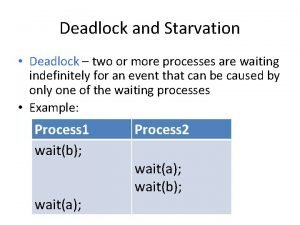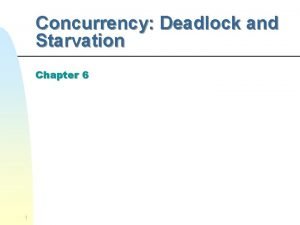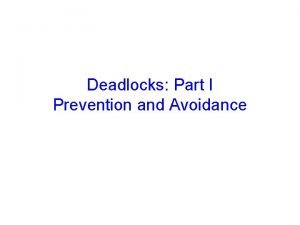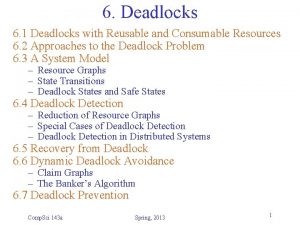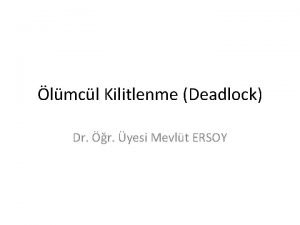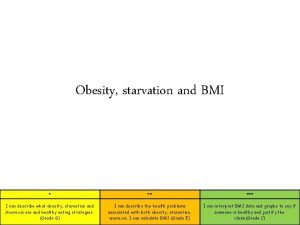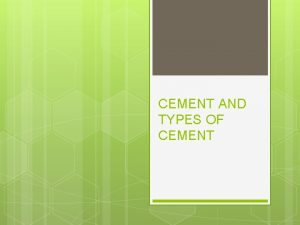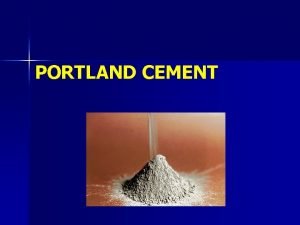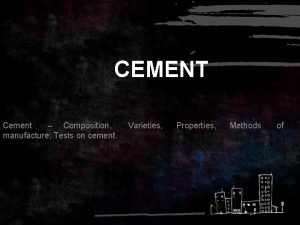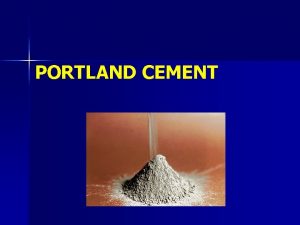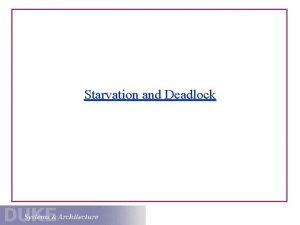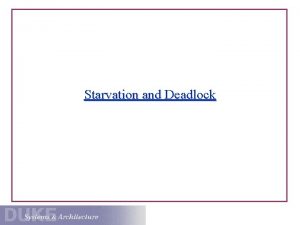Soil Cement Taylor Hogan and Marissa Karpack Starvation















- Slides: 15

Soil Cement Taylor Hogan and Marissa Karpack Starvation Dam, Utah, via USBR

Objectives ● The purpose of soil cement in river engineering is to construct drop structures and armor embankments, dikes, levees, channels, and coastal shorelines ○ Dry regions are perfect for the application of soil cement ● Soil-cement is used where riprap rock is scarce or difficult to transport ○ Common in the Central and Southwestern US ● Soil-cement can be installed beneath banks with fill above to protect to an anticipated total scour depth

Soil-Cement Basics ● Soil-cement is a mixture of existing soil on site with standard cement ● Placed in lifts, usually using heavy equipment ● Compacted using rollers to increase density ● Cured with water so cement hydrates and strengthens ○ ○ Unlike typical concrete, soil particles will not be entirely coated in cement paste Pockets of un-cemented soil remain within the mixture ● Flat blanket on shallow slopes, stair-stepped if steep Smoothing and compaction of Soil-cement lifts (via ACI)

History of Soil-Cement ● Post WWII : Many water resource projects planned in the Southwest and Central US ○ Riprip not locally available for dams, and therefore expensive ● 1940’s : USBR begins research on soil-cement as alternative to riprap ● 1951: Full scale test at Bonney Reservoir, CO ○ Test site experiences waves, ice, and repeated freeze-thaw ○ 10 year observation period of test section ● 1961: USBR approves of soil-cement use for Merritt and Cheney Dams ● 1961 -Present : More than 400 major soil-cement slope protections projects in US and Canada Bonney Reservoir Soil Cement 57 years after placement (from ACI)

Advantages ● Significant cost reduction over riprap if rock is not locally available ● Can be visually appealing compared to riprap ● Design and construction are quick and simple relative to traditional concrete structures ● Can be constructed with local and/or recycled materials ● Demonstrated history of effective slope protection since initial test section in 1951 LA soil cement project: http: //sewardgeo. com/projects. html

Disadvantages ● Higher up-front cost than most riprap ○ ○ Requires more heavy machinery to transport, place, and compact More skilled labor required than riprap placement Cannot be installed in inclement weather ● Relatively impermeable ○ ○ Can fail if soil behind and beneath the cement layer is saturated ● Very brittle ○ ○ Soil cement in need of repair at Cheney Dam (from USBR) Can crack with freeze-thaw cycles Minimal applied loading from people/vehicles can crack surface

Soil Cement Failure Mechanisms Undercutting : occurs with bed degradation, or when cement is not extended deep enough Rillito River, AZ Scour: occurs with high flows and heavy sediment loads, especially with cobbles/boulders Salt River, AZ Loss of support : occurs when water is able to erode sediment behind soil-cement blanket Rillito River, AZ All images from Hansen et al. 2011

Design Considerations- Material Composition https: //m 2 ukblog. wordpress. com/2017/04/05/soil-cement/ ● Soil Composition ○ Easily pulverized soils with at least 5% but no more than 35% silt and clay ○ Finer soils will be harder to pulverize and will require more cement ○ 100% Granular soils (No materials passing No. 200 sieve) will also require more cement ● Cement Composition ○ Typically 8 -15% cement is mixed with the soil ● If the flow carries enough bedload to be significantly abrasive and the flow velocities exceed 6 -8 ft/s then special attention to aggregates is needed ○ Aggregates should contain at least 30% gravel particles retained on a No. 4 sieve in these flow conditions

Design Considerations - Soil Cement Strength/Mix Design ● Must have a 7 -day compressive strength of 750 psi ○ ○ 24 hour test is run to monitor the mix design. These samples are usually about 50 -60% of the 7 day compressive strength A 24 hour test is completed every day for the mix coming from the plant ● Two main cementitious material options ○ ○ https: //www. test-llc. com/strength-testing/ 100% portland cement 85% portland cement and 15% fly ash by weight

Design Considerations - Material Location • Does the on-site soil match the requirements of soil cement? • • • In the case that the soil is not adequate, an offsite plant can be used to premix suitable soil and cement to form the soil-cement • • https: //www. stoltzspreaders. com/ If not, off-site material will be considered. This will be more expensive but better quality If it does then it will be significantly cheaper The location cannot be further than 30 minutes from the project site Must be closer if the temperature exceeds 90 F or there is wind that promotes drying

Design Considerations - Slope ● Soil Cement has been found to work on many slopes ○ Best results at or below 3 H: 1 V ○ No steeper than 2 H: 1 V ○ If the slope is too steep then the layers cannot be very wide ● Based on the slope and application, two different methods can be used ○ Stair Step Method ■ Layers of soil cement stacked and staggered on each other ○ Plating Method ■ A single layer of soil cement installed on an embankment https: //allevents. in/wharton/soil-cement-slope-protection-lane-city-reservoir-coursetour/1692370244126491

Design Considerations - Stair Step Method ● The stair step method is appropriate for larger slope protection projects ○ Each layer is approximately 6 inches thick and 6 -9 ft wide ■ 8 ft is preferred to accommodate the necessary equipment ● Relationship between the horizontal layer width (W), slope of embankment (S), thickness of compacted layer (v) and minimum facing thickness measured normal to the slope (tn) is:

Design Considerations - Plating Method ● Practical for smaller slope protection projects ● Consists of a single layer of soil cement placed parallel to the embankment ● Applied to slopes of 3 H: 1 V or less ● The edge of the soil cements layer should be tied into a non-erodible section or abutment to prevent undermining of the rigid soil cement layer ○ Common methods include riprap aprons, extending soil cement layer below the anticipated degradation/scour depth, or installing a cutoff wall below the degradation depth

Design Considerations - Grade Control Structures ● Soil Cement can be compacted in layers to form grade control structures that are very cheap compared to their concrete counter parts ● The picture below shows a drop structure that is one of 18 installed on Marcy Gulch in Highlands Ranch, CO to decrease the slope of the ephemeral stream and help prevent further degradation

Placement Process • Soil cement can be mixed on site or in a batch plant • • Soil cement is placed on top of moistened subgrade • • Watering soil cement to prevent cracking at Starvation Dam (from USBR) Can be placed on top of older soil cement to retrofit or extend the bank protection Successive layers should be placed immediately • • • Batch plant is higher quality but more expensive Drying between layers creates weak seams Must be compacted within 30 minutes of placement Exposed surfaces must be kept moist to cure • • Typically 7 days to acceptable cure Covered with a protective curing material
 Deadlock and starvation
Deadlock and starvation Deadlock and starvation
Deadlock and starvation Deadlock summary by chapters
Deadlock summary by chapters Cowhorn orthosis
Cowhorn orthosis Living soil vs dead soil
Living soil vs dead soil Living soil vs dead soil
Living soil vs dead soil Conjoined twins trishna and krishna
Conjoined twins trishna and krishna Class a combustible material
Class a combustible material Starvation vs deadlock
Starvation vs deadlock Deadlock prevention vs avoidance
Deadlock prevention vs avoidance Deadlock vs livelock
Deadlock vs livelock Deadlock detection prevention and avoidance
Deadlock detection prevention and avoidance Ventilator waveform analysis
Ventilator waveform analysis A natural physical drive that prevents starvation
A natural physical drive that prevents starvation Starvation bmi
Starvation bmi Starvation diabetes mellitus
Starvation diabetes mellitus
